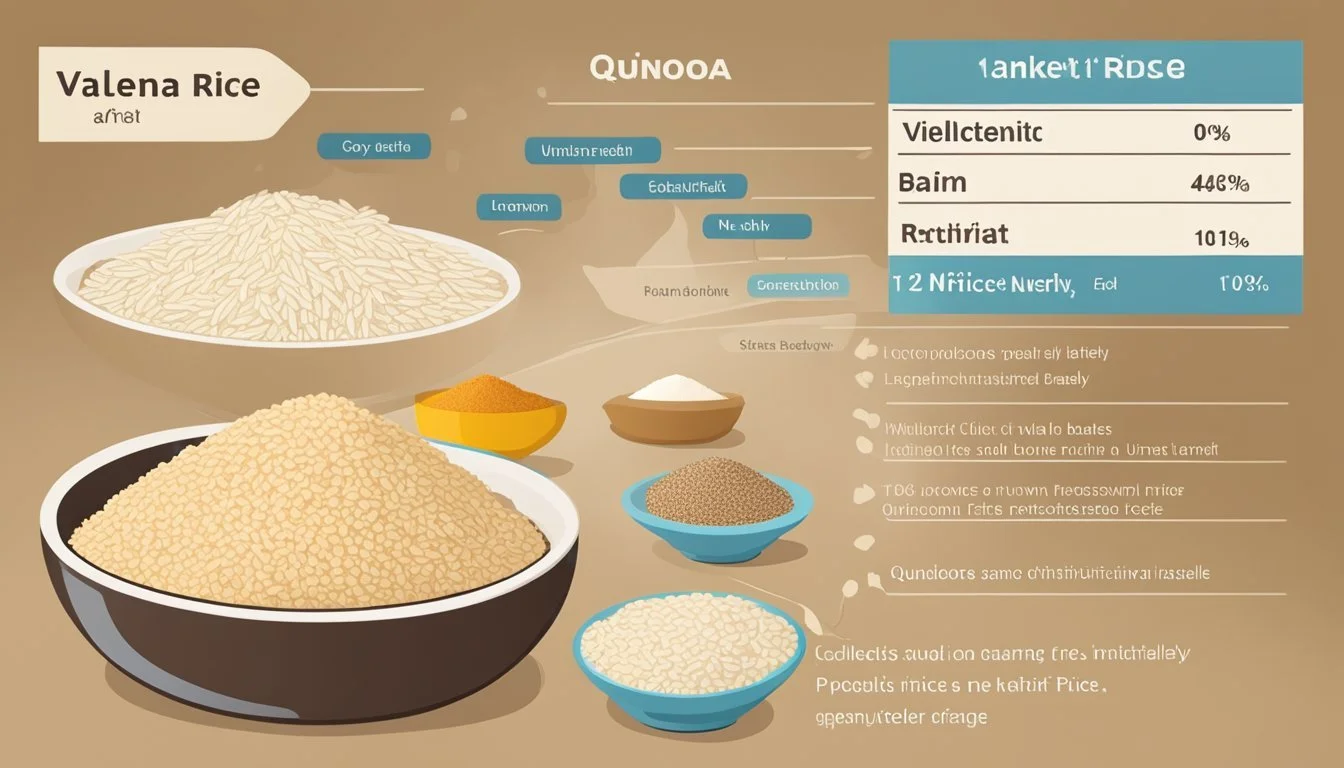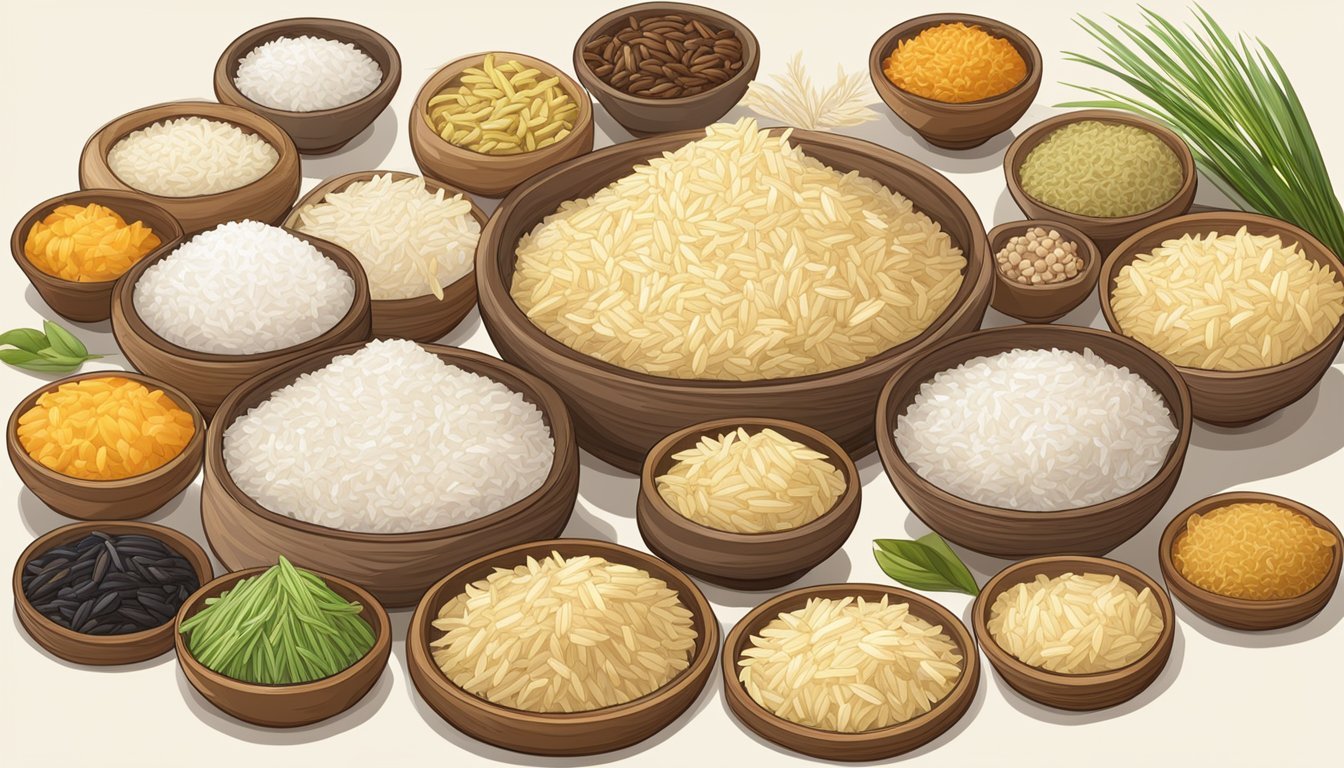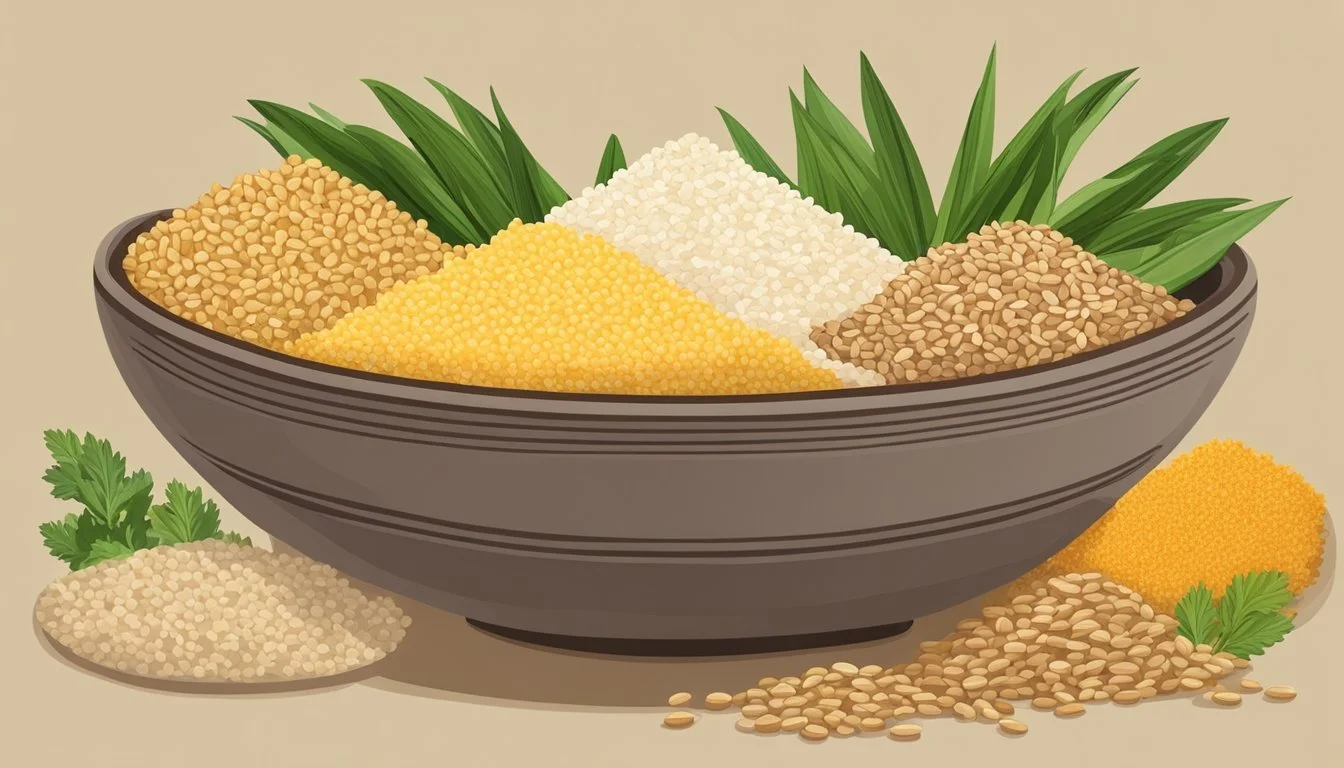Valencia Rice Substitutes
Best Alternatives for Authentic Paella
Valencia rice is a staple in many classic dishes, particularly in the famous Spanish paella. For those seeking alternatives, several types of rice can effectively replace Valencia rice in recipes. Short-grain rice, for instance, is a popular choice due to its similar texture and cooking properties. These grains absorb flavors well, making them an excellent substitute for traditional paella rice.
Other notable substitutes include Bomba, Calasparra, and Arborio rice, each offering unique qualities suitable for various dishes. Bomba rice, known for its ability to absorb liquid while maintaining firmness, is often touted as the best option. Calasparra rice, another Spanish variety, shares these characteristics, providing a similar bite and flavor profile. Arborio rice, commonly used in risotto, can also be a good stand-in due to its creamy consistency when cooked.
Selecting the right rice substitute doesn't have to be a daunting task. By understanding the specific qualities of each type, anyone can confidently choose the best rice for their culinary needs. Whether for paella or other recipes, these alternatives ensure that the dish remains authentic and enjoyable.
Understanding Valencia Rice
Valencia rice, a short-grain variety from Spain, is pivotal in dishes like paella due to its unique characteristics and specific culinary applications.
Characteristics of Valencia Rice
Valencia rice, native to the Valencia region in Spain, is recognized for its short grains and sticky texture. The grains are plump and become tender when cooked, making them ideal for absorbing flavors. This rice also has a subtle sweet flavor which complements various ingredients in traditional Spanish dishes. Another notable feature is its high starch content, which contributes to the creamy consistency in preparations like paella.
Common Uses for Valencia Rice
Valencia rice is most famously used in paella, a beloved Spanish dish cooked in a wide, shallow pan. Beyond paella, it excels in other regional dishes such as arroz a banda and arroz negro. Its ability to absorb liquids and flavors makes it perfect for rice-based meals requiring a rich, cohesive texture. This rice is versatile and can be used in soups, stews, and risottos, highlighting its importance in both traditional and contemporary recipes.
Nutritional Profile of Valencia Rice
Valencia rice, known for its unique texture and flavor, offers a wealth of nutritional benefits.
It provides a moderate amount of calories, making it a good source of energy for daily activities. A typical serving of Valencia rice contains around 130-150 calories.
Carbohydrates are the primary component, providing the necessary fuel for the body. It has about 28-30 grams of carbohydrates per serving.
Though not particularly high in protein, Valencia rice offers around 2-3 grams per serving, which can contribute to your daily protein intake.
In terms of fiber, Valencia rice contains a modest amount, typically about 1 gram per serving. This can aid in digestion and maintain intestinal health.
Valencia rice also includes modest levels of vitamins and minerals. It contains small but essential amounts of vitamins such as B-vitamins, which are crucial for energy production.
Mineral content includes trace amounts of iron and magnesium. These minerals support various bodily functions, such as oxygen transport and muscle function.
This rice type is low in fat, with less than 1 gram per serving, making it a heart-healthy option.
Overall, Valencia rice is a nutritious component of a balanced diet, offering essential nutrients in manageable quantities.
Criteria for Choosing Rice Substitutes
When selecting a substitute for Valencia rice, texture plays a crucial role. Valencia rice is known for its slightly round grains that retain a firm yet tender consistency. Choosing a rice with a similar texture ensures the dish maintains its authentic feel.
Flavor is another important criterion. Valencia rice has a mild taste that absorbs flavors well. Opt for varieties that can also take on the essence of the dish, such as Arborio or Calasparra rice.
Nutritious value could be essential for those seeking healthier options. Consider brown rice, which offers more fiber and nutrients but might slightly alter the dish’s texture and flavor.
Cooking methods should align with those used for Valencia rice. Most suitable substitutes will cook well in the traditional methods used in Spanish cuisine, like simmering with a combination of broth and spices.
Lastly, consider the cooking time. Valencia rice usually cooks within 20-30 minutes. Substitutes like Arborio or Bomba rice have similar cooking times, making meal preparation straightforward.
Here's a quick reference table:
Rice Variety Texture Flavor Cooking Time Nutritional Value Bomba Firm, round Mild, absorbs flavors well 20-25 minutes Moderate Arborio Creamy, firm center Mild, absorbs flavors 18-20 minutes Moderate Calasparra Firm, slightly chewy Mild, excellent absorption 20-25 minutes High Brown Rice Chewy, dense Nutty, distinct 40-45 minutes High
These criteria should guide you in selecting the best rice substitute for your culinary needs.
Rice Varieties as Substitutes
When considering substitutes for Valencia rice, it's essential to examine short-grain, medium-grain, and long-grain rice varieties. Each type offers unique textures and flavors suitable for different culinary applications.
Short-Grain Alternatives
Bomba Rice stands out as a primary substitute for Valencia rice, especially in dishes like paella. Bomba rice absorbs liquid well, allowing it to retain its firm texture without becoming mushy.
Sushi Rice is another viable option due to its sticky consistency, making it suitable for recipes requiring a cohesive texture. Despite its primary use in Japanese cuisine, it can be a practical substitute for dishes needing short-grain rice.
Medium-Grain Alternatives
Calasparra Rice is ideal for replicating the texture of Valencia rice in various recipes. It has a similar absorption quality, making it perfect for stews and paellas.
Arborio Rice is noteworthy for its creamy texture, making it the go-to choice for risottos. Although it differs slightly in texture from Valencia rice, it works well in recipes where a creamy consistency is desired.
Carnaroli Rice is another excellent medium-grain option known for its high starch content, providing a creamy texture similar to arborio but with a firmer bite, suitable for creamy dishes.
Long-Grain Alternatives
Jasmine Rice offers a floral aroma and slightly sticky texture. It can be used in recipes where a fragrant, yet somewhat cohesive rice is needed.
Basmati Rice is characterized by its long, slender grains and aromatic quality. It is ideal for dishes requiring individual, non-sticky grains, although it is best suited for non-creamy recipes.
Brown Rice provides a nutty flavor and chewier texture. While it differs significantly from Valencia rice in consistency, it is a healthy alternative that can bring a different dimension to various dishes needing long-grain substitutes.
Grains and Seeds as Substitutes
Choosing the right grains and seeds can provide a nutritious and unique alternative to Valencia rice. This section explores various options that offer different textures and flavors, catering to diverse culinary needs and dietary preferences.
Quinoa: A Nutritious Rice Alternative
Quinoa is a protein-rich grain that is often used as a rice substitute. It contains all nine essential amino acids, making it a complete protein source. Quinoa is gluten-free and highly nutritious, packed with fiber, vitamins, and minerals such as magnesium, iron, and potassium.
Cooking quinoa is fast and easy; it usually takes about 15-20 minutes. To prepare, rinse the quinoa thoroughly to remove its natural coating, saponin, which can be bitter. Use a 1:2 ratio of quinoa to water or broth. Bring to a boil, reduce heat, and simmer until the liquid is absorbed and the quinoa is tender.
Barley: Adding Chewy Texture
Barley is another excellent substitute for Valencia rice. It has a chewy texture and nutty flavor that works well in soups, stews, and salads. Barley is rich in fiber, particularly beta-glucan, which has been linked to heart health benefits.
To cook barley, use a 1:3 ratio of barley to water or broth. Pearl barley, the most common form, takes about 25-30 minutes to cook, while hulled barley requires about 45 minutes to an hour. Barley pairs well with robust flavors and can add a satisfying chew to many dishes.
Bulgur Wheat: Quick-Cooking Substitute
Bulgur wheat is a versatile grain made from cracked wheat. It is partially pre-cooked, which makes it a quick option for busy kitchens. Bulgur is high in fiber and has a mild, slightly nutty flavor that complements various recipes.
To prepare bulgur wheat, use a 1:2 ratio of bulgur to boiling water. Let it soak for about 10-15 minutes, fluffing with a fork once the water is absorbed. It is a popular ingredient in Middle Eastern dishes, such as tabbouleh, and can be used in casseroles and pilafs.
Farro: An Ancient Grain Option
Farro is an ancient grain that has been cultivated for thousands of years. With a nutty flavor and chewy texture, it is an excellent substitute for rice in many recipes. Farro is rich in fiber, protein, and several vitamins and minerals, including magnesium and iron.
Cooking farro involves using a 1:3 ratio of farro to water or broth. Simmer for about 30-40 minutes until the grains are tender but still chewy. It can be used in salads, soups, and as a side dish, providing a hearty and satisfying alternative to rice.
Low-Carb and Gluten-Free Alternatives
For those seeking low-carb and gluten-free options to replace Valencia rice, there are notable alternatives that stand out for their nutritional benefits and culinary versatility. Cauliflower rice, broccoli rice, and shirataki rice are excellent substitutes that cater to various dietary lifestyles, including keto.
Cauliflower Rice: Versatile and Healthy
Cauliflower rice is a popular low-carb alternative that fits well in many dishes. Made by grating or processing cauliflower into small, rice-like pieces, it offers a neutral flavor that easily absorbs seasonings.
A 50g cooked serving of cauliflower rice contains roughly:
Calories: 11.5
Fat: 0.3g
Carbs: 2g
Fiber: 1g
Net Carbs: 1g
It's highly versatile, complementing stir-fries, salads, and as a base for bowls. Given its low calorie and carbohydrate levels, cauliflower rice is also appealing to those on a keto diet.
Broccoli Rice: Adding Green to Your Diet
Broccoli rice is another excellent low-carb and gluten-free substitute. Made from processed broccoli stems or florets, it provides a unique texture and a slight broccoli flavor.
Per 1 cup serving, broccoli rice offers:
Calories: 25
Fat: 0g
Carbs: 4g
Fiber: 2g
Protein: 2g
Rich in vitamins and minerals, broccoli rice adds nutritional value while keeping carb counts low. It’s great for adding color and nutrients to dishes like casseroles, stir-fries, and salads.
Shirataki Rice: Carb-Free Option
Shirataki rice, derived from the konjac plant, is a carb-free option favored by those on strict low-carb or keto diets. It’s composed mainly of water and glucomannan fiber, making it nearly calorie-free.
A typical serving size of 1/2 cup offers:
Calories: 20
Fat: 0g
Carbs: 4g
Fiber: 2g
Protein: 2g
Shirataki rice stands out for its unique chewy texture. It’s best used in dishes where its ability to soak up flavors enhances the meal, such as in soups, stews, or savory sauces. It’s also entirely gluten-free, making it suitable for various dietary needs.
Unique Rice Substitutes in Cooking
When looking for substitutes for Valencia rice, options such as orzo pasta, couscous, and wild rice offer interesting alternatives. Each brings unique textures and flavors to dishes, making them valuable in diverse cuisines.
Orzo: Pasta with a Rice-Like Appearance
Orzo, a type of pasta, resembles rice grains but is made from wheat. It can easily replace rice in many recipes due to its similar size and shape. Orzo cooks quickly, typically within 10 minutes, making it ideal for weeknight meals. It absorbs flavors well, so it integrates smoothly into soups, salads, and side dishes.
For a creamy texture, cook orzo in broth instead of water and stir in cheese or butter at the end. Orzo can be used in Mediterranean dishes, such as Greek salads, and pairs well with fresh herbs, lemon, and olives.
Couscous: A Quick Rice Substitute
Couscous consists of small, steamed balls of crushed durum wheat semolina. It has a light and fluffy texture, making it an excellent and quick-cooking substitute for rice. Instant couscous cooks within 5 minutes by just adding boiling water and letting it steam, offering a rapid alternative for busy days.
Couscous is versatile, suitable for sweet and savory dishes. It can be mixed with vegetables, nuts, and dried fruits for a nourishing salad or used as a base for stews and tagines. Its mild flavor allows it to pair well with a variety of spices and ingredients.
Wild Rice: A Nutty and Flavorful Choice
Wild Rice is not technically rice but a type of grass seed. It has a distinct nutty flavor and a chewy texture, providing a different eating experience compared to traditional rice. Wild rice often requires longer cooking times, approximately 45 minutes to an hour, but it offers a rich taste profile worth the wait.
It is high in protein and fiber, making it a nutritious option. Wild rice works well in hearty dishes, such as casseroles, soups, and pilafs. Combining wild rice with other grains can add depth and complexity to side dishes or main courses.
By incorporating these substitutes, cooks can experiment with new flavors and textures while still achieving satisfying results in their recipes.
Incorporating Rice Alternatives into Recipes
Using rice alternatives can enhance your dishes by adding new textures and flavors. These substitutes can be seamlessly incorporated into various recipes such as paella, sushi, risotto, rice pudding, and salads.
Substitutes for Paella Rice
For paella, Basmati and Jasmine rice can serve as suitable replacements due to their aromatic qualities.
Bulgur is another option that offers a nutty flavor and similar texture. It should be cooked in a 1:2 ratio of bulgur to water.
Quinoa provides a protein-rich variant that cooks quickly, roughly 15-20 minutes, which makes it suitable for a time-efficient version of paella.
These substitutes absorb flavors well, ensuring the dish remains flavorful.
Alternatives for Sushi and Risotto
Sushi rice can be replaced with Cauliflower Rice for a low-carb option. This involves grating cauliflower and steaming it lightly.
For Risotto, Arborio Rice is traditionally used, but Farro can be substituted for a chewier texture and more fiber. It should be cooked similarly by adding broth gradually and stirring frequently.
Barley is another alternative that provides a slightly nutty flavor and creamy consistency, suitable for risotto.
Creative Ideas for Rice Pudding and Salads
For Rice Pudding, Millet offers a similar creamy texture while being gluten-free. It can be cooked with milk or a milk alternative, sweetened, and flavored with vanilla or cinnamon.
Chia Seeds can also be used to create a pudding-like consistency and add health benefits such as omega-3s.
In Salads, Couscous and Bulgur can replace traditional rice, adding more texture and flavor. They can be tossed with fresh vegetables, herbs, and a light dressing.
Quinoa also makes for a high-protein alternative that pairs well with both roasted vegetables and leafy greens.
By incorporating these rice alternatives, a variety of culinary experiences can be achieved without sacrificing nutrition or flavor.
Considerations for Dietary Restrictions
Choosing the right rice substitute often depends on specific dietary restrictions. Vegan and grain-free diets have different requirements, but both can benefit from a range of nutrient-rich alternatives.
Vegan Rice Substitute Options
Vegan diets eliminate animal products, necessitating plant-based rice alternatives. Options like quinoa, brown rice, and wild rice are excellent choices.
Quinoa: High in protein and fiber, quinoa serves as a complete protein source, offering all nine essential amino acids. It cooks quickly and can be used in various dishes similar to rice.
Brown Rice: Rich in fiber and essential nutrients, brown rice is another plant-based staple. Its chewy texture makes it suitable for hearty dishes.
Wild Rice: Though not technically rice, it is nutrient-dense and provides a crunchy texture, making it a versatile substitute.
These substitutes can be prepared in a variety of ways to suit different recipes and maintain a vegan diet.
Solutions for Grain-Free Diets
Grain-free diets can benefit from rice substitutes like cauliflower rice and spiralized vegetables.
Cauliflower Rice: When processed in a food processor, cauliflower can mimic the texture of rice. It is low in calories and carbs but high in vitamins and nutrients. Often used in keto and low-carb diets, it provides a light and versatile base for many dishes.
Spiralized Vegetables: Zucchini and carrots can be spiralized to create noodle-like substitutes. These vegetables are low in calories and offer a different texture while maintaining essential nutrients.
Chia Seeds: When soaked and combined with other grains, can offer a rice-like texture while fulfilling grain-free requirements.
Both options provide nutritious, low-carb alternatives suitable for those avoiding grains.









